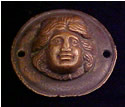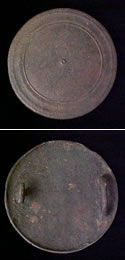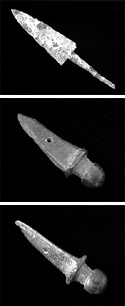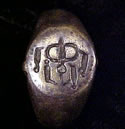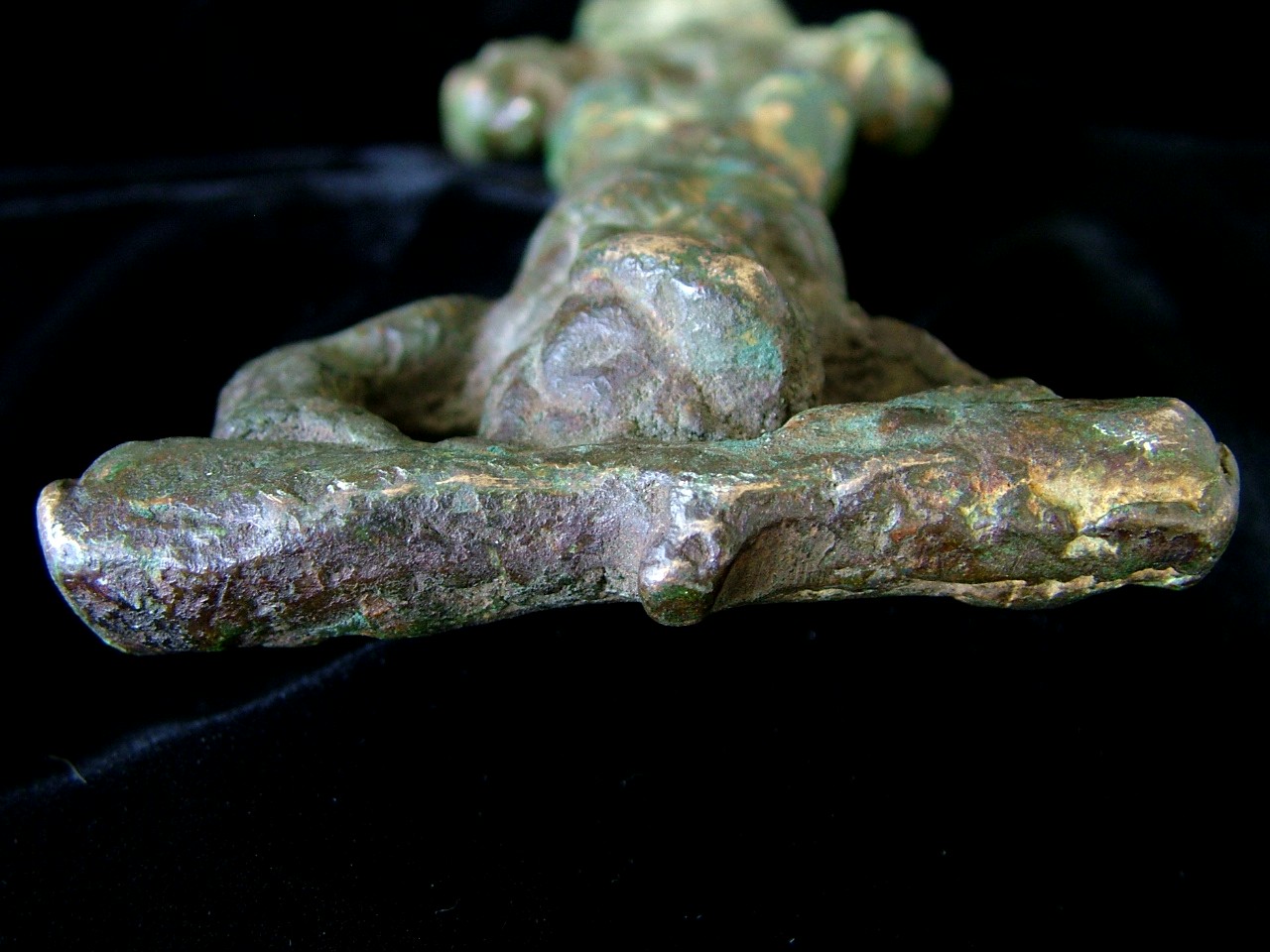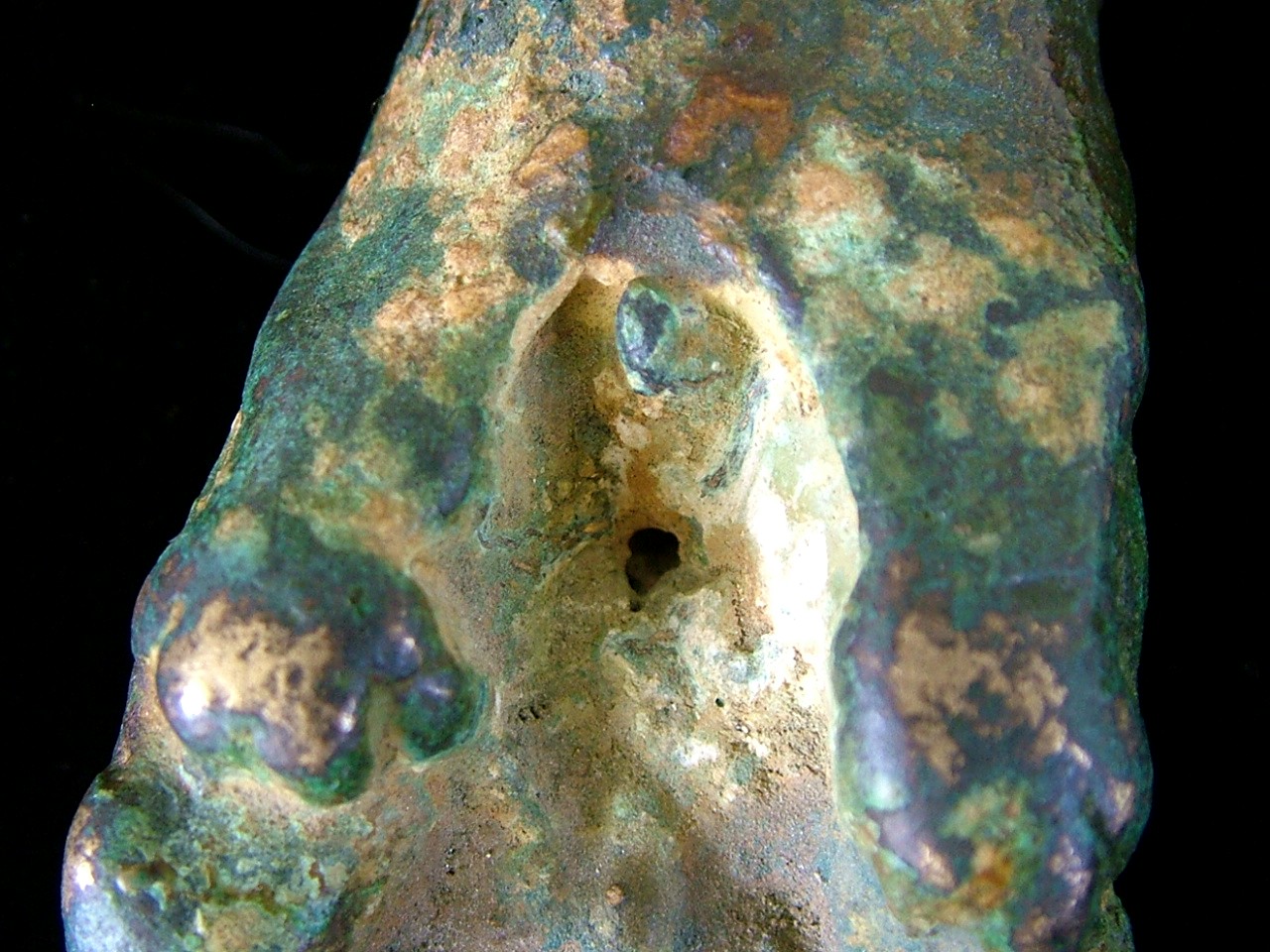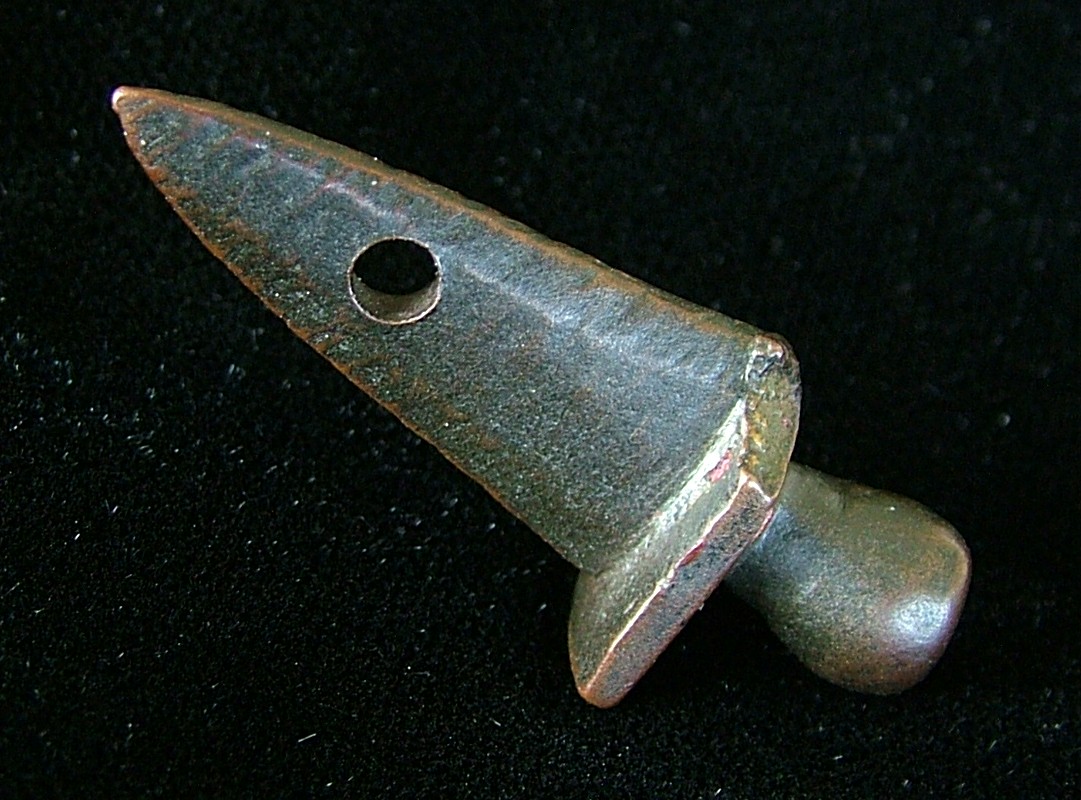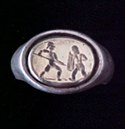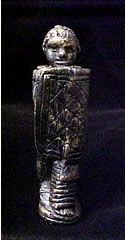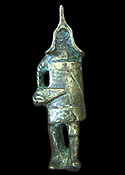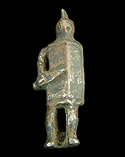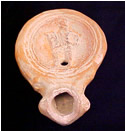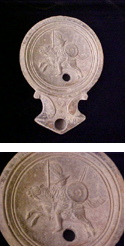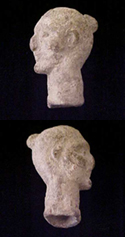 |
|---|
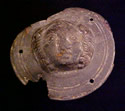
|
ROMAN GLADIATOR
HELMET MEDUSA INSIGNIA |
||
Material: Bronze/Iron
Era: 2nd to 3rd Century AD Culture: Roman Style: Roman Origin: From a Dealer in NY |
|||
| |
|||
| ROMAN GLADIATOR
HELMET MEDUSA INSIGNIA |
|||
Material: Bronze/Iron
Era: 2nd Century AD Culture: Roman Style: Roman Origin: From a Dealer in NY |
|||
| |
|||
| ROMAN GLADIATOR
BELT BUCKLE |
|||
Material: Bronze
|
|||
| |
|||
| ROMAN SECUTOR OR MURMILLO GLADIATOR SHORT GLADIUS (Sword) OR PUGIO (Dagger) AND PENDANT |
|||
| Material: Iron, Bone Residue, and Bronze The amount of fossilized bone and wood residue on the blade and tang suggest that the weapon's handle and guard had been made of bone and wood. Most likely this short gladius or pugio and pendant had been for a Secutor or Murmillo gladiator, or it is also possible that these had been made for a gladiator fan. Both artifacts were purchased at the same time from the same source. |
|||
| |
|||
| ROMAN GLADIATOR
SCORE CARD SEAL RING (This ring had most likely belonged to a Doctore, a Gladiator Instructor, it is thought that at least some Doctores were retired Gladiators) |
|||
Material: Bronze
Era: 2nd Century AD Culture: Roman Style: Roman Origin: An Antiquities Dealer from New Jersey |
|||
| |
|||
| ROMAN CONCRETE GLADIATOR; ADVERTISEMENT, DISPLAY, OR FAN'S SHINGLE |
|||
Material: Concrete
Found at the Roman Amphitheater at El Jem, Tunesia in the 1930's. This Concrete (from volcanic ash and lime) Gladiator; Advertisement, Display, or Fan's Shingle is 18.9 cm x 14.3 cm, 17 mm thick, and weighs 0.43 Kgs (approx. 1 pound). |
|||
| |
|||
| ROMAN SECUTOR GLADIATOR CEREMONIAL GLADIUS OF COMMODUS AS HERCULES OF THE NORTH |
|||
Material: Calamine Brass (Aurichalum), Lead Overlay, and Traces of Gold Gilding The follow up with additional info. on this artifact was put on hold for several different reasons, this will now be concluded by early summer 2017! Although I have been meaning to update some of the info. on this artifact here for years, due to other projects I have not been able to get to it, with that said this has been particularly so over the last year - needless to say for the time being and with notes (that include dates) I am required to leave the info. here as it is. So over the next few weeks I will make a another page with the new info. on this artifact with a link just above here, be prepared for a few surprises. Other info: Research that includes the two swords in Europe (as well as info. with other swords in a private collection that I am not allowed to disclose) now suggests that all three swords mentioned were produced using the lost wax indirect casting method (usually for statue parts, but in this instance for solid casting) in one of the Roman cities on the Gulf of Pozzuoli, Italy (most likely at Pozzuoli or Baiae) during the early part of Septimius Severus's reign. I have little doubt that they were connected to the Flavian Amphitheater at Pozzuoli and the Classis Misenensis at Misenum. As mentioned with the update below - the two swords in Europe just like this sword have paint with the patina (as well as those in a private collection). One sword is like this example, but with the blade broken (approx. one cm below the hilt), it is an even break with both ends of the break showing encrustation. Every indication is that it had been ritually broken in antiquity, most likely symbolizing a death, a defeat, or a failure. The other sword is a bit smaller and eastern in style, all indicators suggest that it was from the same ancient foundry. The shape is as a large spearhead with the hilt having two looped inward bird heads, this suggests an association with a Scythic people, or of that tradition. It appears that the two swords in Europe were companion votive's that among other things represented the east and the west in connection to Hercules, of course I now know that the companion sword to my sword is missing. The fact that only one of the swords in Europe is broken suggests that it represented a failure associated with the west, most likely a naval expedition to the west. As mentioned below I have not done a hands on inspection of the swords from Europe, also I do not have permission to share pictures of those swords at this time. 30 Nov. 2016 - Dave Kenney The additional information and pictures of this sword are scheduled to be released in May, 2016. In the meantime, with permission, I can post the following: I received pictures by a European owner of a similar votive sword made of bronze that was excavated in Europe with another bronze sword of a different type. Both swords show paint with the patina (mainly on the blades) and in my opinion are very much connected. Although the art style is slightly different, the theme seen on the paint of the similar sword blade is close to that depicted with the fossilized paint/resins on the blade of my artifact, while also once again being slightly different. Although I have no reservations that both bronze swords are authentic, it still is not possible to fully authenticate (or discredit) any purposed artifact by just viewing pictures; needless to say both those swords look extremely good as ancient. Depending on the wishes of the owner of these swords, the information that could be permitted to be shared may be most significant. On another note, via request by a few earnest fellow researchers, I will share a bit more information on an undisclosed Commodus connection to this sword that I have mentioned over the years. It is easy if you are familiar with Roman bind inscriptions, if so then just look at the Roman bind letters mixed in with the design of the upper part of the statuette hilt and you will see "COMDVS", but yet there is more. All this will be better seen when I get to the additional photography taken at slightly different angles, that will now be published on here in Nov. 14, Mar. 2016 / updated on 29 May and 29 June - Dave Kenney The write with the sword on this page contains the original information and pictures posted in 2005, along with revisions done in 2008. Along with a few forthcoming edits there is additional information that will soon be added along with more images (possibly in a new page) as soon as I complete the ancient North American project I am currently working on (which will also involve updates to the Thunderball page as well as adds to the RO home page). In the meantime, the following is just a bit of new information excerpted from my project notes. Further study in relation to this sword was initially prompted by my findings in 2008 that suggested that some of the sword's symbolism appears to have been connected to the North Atlantic Ocean. I did additional studies in December 2012 on a Roman metal votive artifact found in West Virginia, then a bit more in August of 2014 researching an ancient Native American stone tool/Roman votive artifact from Pennsylvania. Symbolism contained on both of those artifacts appear to indicate at least a Roman knowledge of the Cape York meteorite in Greenland, and possibly with a keen interest. To note, earlier Romans appear to be associated with the artifact from WV, and those from a bit later with the artifact from Pennsylvania. From additional findings - some notes on this sword: According to Roman writings about Commodus that are supported by Roman coin artifacts, the sword appears to have been cast sometime between 190 to 192 AD. The sword's statuette hilt is styled for a left-handed grip with the statuette facing outward and upward, yet it is specifically designed for a more secure right-handed grip with the statuette facing inward and upward. The style vs. design makes sense as it was noted by Dio that Commodus was left-handed, but if used in a ritual or ceremony then the sword likely would have been used by someone right-handed. The sword is weighted so that when held in one of the two mentioned grips, the bottom side of the blade is heavier. The sword is also weighted and balanced so that if placed vertically against a flat surface such as a wall, with the tip resting on a soft surface such as cloth or soil, it will stay in that position securely. The larger images with the remnants of paint/tints on the blade's front shows prominent themes of the defeat and binding of foreign figures (deities) associated with blade weapons. As noted in my 2005/08 writings on this statuette hilt's form, it can be interpreted as being styled and mixed with two types of ancient sword hilts, and according to my new findings in 2014, possibly three: the Celtic Le Tene anthropomorphic sword hilt; the Scythian or Sarmatian T-pommel akinakes hilt; and the late bronze age to early iron age European antenna sword hilt. In essence it represents a binding of the primary weapons of barbarian deities by Commodus as Hercules, the son of Zeus for Rome. The statuette hilt's overhead piece of driftwood, that may also be a tree trunk and/or tree branch, etc., appears on the back as a large club in various positions (that transform) that among other things depict the destruction of a type of primitive shrine and the binding of a couple of figures. The central theme of the shrine depicted appears to be a type of Irminsul of the north associated with the magnetic that includes solar worship, and at least some of its theme may be associated with the legendary Thule. Yet it appears that it is not only of the Germanic tribes but also of the Sarmatians, as well as possibly the Celtic Britons and Picts (Commodus received the following titles during his reign: Germanicus in 172 AD; Sarmaticus in 175; Germanicus Maximus and also Britannicus in 182). My observations based on over a decade of research of artifacts from various ancient European and Asian cultures of different eras suggest that at some point in antiquity there was a widely held belief among tribal peoples of central to northern Europe and Asia, that there was a legendary or mythical sacred island, or islands, or place to the far north in the west that was associated with a meteor strike; iron; the magnetic; the water compass; navigation; a blade smith deity; a volcano (that included volcanic lightning); a war deity (connected to a warrior); a female sea deity who can be armed; fertility; regeneration; solar worship; a suggestion of prophecy; and the celestial (most notably the Pole star). Most likely much of that belief was based on ancient sea lore about visitations to Iceland and Greenland - that traveled among peoples who did not have a known, or accepted, written language. Notice that when the sword is vertically oriented to the north with the blade downward, the statuette hilt's face looks to the west. 30, Dec. 2015, Dave Kenney. Original information with pictures: This sword is a highlighted artifact on Part 2, Disc 4, 24: "Emperors as Performers" of The Teaching Company's Course: "Experiencing Rome: A Visual Exploration of Antiquity's Greatest Empire". It is of Commodus as Hercules of the North (either Septubus, Arctos, or both), other titles may have been Hercules of the Midnight Sun, Hercules Lapis (lodestone), Hercules Orbis (Hercules of the World), or Hercules Navalis (Hercules of the Seas and, or Oceans). His overhead club may represent a piece of driftwood, suggesting Hercules as the first sailor, if so then may also be a Scythian (and later Sarmatian) connection to this (if this interest you go to the "Saxon Ring Of Arthur As The Scythian Navigator, Thunderer, and War god" on www.kingarthurbanner.com. This may be why there is a slight curve with the hilt, is so then the feet are planted as the Pillars of Hercules, but the hilt is of a North Atlantic (more likely as an Isle of the North Atlantic) theme. This is a type of Hercules that I have been researching for several years, he is usually seen with a cup in his right hand. He is generally not known in typical Greek or Roman inscriptions or votives, this may be due to his association with the lode stone (Hercules Lapis) and the water compass (as Hercules's Magnetic Cup). The ancient peoples of the Mediterranean may have considered the water compass as a nautical secret. This may have been the type of Hercules that Commodus worshipped most, it may have also been the same with gladiators. Information on the "Roman Sarmatian Navigator's Nose Ring Of Ala I Sarmatarum (a Wing of Sarmatian Cavalry posted to Britannia)" and the "Roman Legionary Ring Of The VI Victrix" that are with this collection suggests that Commodus may have been interested in exploration of the North Atlantic (as the origin of magnetic north as the realm of "Hercules of the North"), there may have also been strategic reasons (with the Roman conflict with Germania) with this. There are indicators that this sword had been made for a ludi (gladiator school), familia gladiatoria (gladiator group), or a collegia gladiatoria (gladiator collegia) The sword's hilt has some lead overlay and a few traces of gold and silver gilding. New information is that this sword "may" have been used in an initiation of a mystery of Hercules and magnetic north, as it also has a theme of a Secutor gladiator gladius then it could suggest that Commodus had given that style of gladiator a hyper status. The Secutor was Commodus's favorite, he often fought in the arena as a Secutor. Pictures 26 thru 30 shows a bronze and lead overlay Thracian slide buckle for an over the shoulder sword belt, it most likely had once been gold gilded. Although it this was purchased from a dealer in the Germany, it most likely originated in the Balkans. An exact but refined depiction as this can be seen on a plate with the Rogozen Treasure in Bulgaria. In the scene Hercules is seated on a rock (with two flowers) with Apollo bowing, Hercules's left foot is on Apollo's right foot and Apollo's covered quiver (symbolizing that his solar arrows are hidden) is under Hercules. My research shows that this depiction is of Apollo bowing to Hercules of the North. This should be Hercules of the Lapis (Hercules of the Stone, or the lodestone) as Hercules of the land of the Midnight Sun. If so then it may have been the Thracians or Proto-Thracians who introduced the water compass to the Phoenicians. Certain depictions on Neolithic Nordic artifacts suggests that the water compass was known in Baltic thousands of years before it's advent in the Mediterranean (if this interest you, then go to the Ancient Miniature Art on this website). There are many indicators that the Thracians and their descendants had continuous contact with the ancient Nordics. This extraordinary Roman gladiator ceremonial
(or votive) gladius is solid caste brass using the lost wax technique.
It measures 46 1/2 cm in overall length with the statue handle
at 17 1/2 cm in length, the blade is 29 cm in length. The statue
handle is 8 cm's at it's widest width with the blade at 4 cm's
wide. It weighs approx. 2 kg. Revised June 08, Dec 015, Nov 016 |
|||
| MAGNETIC HERCULES COMMODUS ARCTOS AND WATER COMPASS |
|||
Information to follow soon. |
|||
| COMMODUS HERCULES ARCTOS SCORE CARD AS SECUTOR (FRONT) AND THRAX (BACK)
|
|||
Information to follow soon. Another example of this type of sword has been brought to my attention by a novice collector in New Jersey, it was purchased years ago in Pennsylvania. It is made of bronze that had been scrubbed, so it may have originated from a collection in Germany. It is slightly larger at 22 1/8 inches in length. The statue/hilt is of a finer design and somewhat more angular, the primary figure may be of Hercules only, or of Commodus as Hercules. The sword appears to have been in a sheath perhaps on a statue of Commodus, some of the dings on the blade appear to have been made from impacting in antiquity, this suggests that it was used in a ritual. The sword's guard is made in the form of a gabled roof of a Roman temple, at least one of the two small intertwined figures inside this are as if taking (picking) one of the balls (this validates my speculation that three balls that are also on the front of my example are in fact the Golden Apples). The first 3 to 4 inches of the blade has a rib with defined edges, this entire area is raised and squared at the bottom as part of the design, the way it is made shows that the sword may have for some unknown reason at times may have been partially drawn. The tip is crudely worked, this also gives more credence to my speculation that it had usually been in a sheath on a statue. In my opinion the sword may or may not have been used in a gladiator Commodus/Hercules ritual, but I am fairly certain that it was used in a Commodus/Hercules cult ritual. After a careful review of this sword and the sword posted here I have no doubt that there is a connection to the symbolism with these swords and the famed marble statue of Commodus as Hercules at the Capitoline Museum, Rome. The collector in New Jersey is offering his sword. If this is of interest then contact me at: roc@romanofficer.com. As a courtesy I will reply with the gentleman's contact information - Dave Kenney. |
|||
| |
|||
| EMPEROR COMMODUS SECUTOR GLADIATOR GLADIUS PENDANT |
|||
Material: Bronze With Thin Lead Overlay
Era: 2nd Century AD Culture: Roman Provincial Style: Roman Provincial Origin: Information to follow soon. |
|||
| |
|||
| ROMAN LEGIONARY RING OF A GLADIATOR COMBAT OF MARCIA AND COMMODUS |
|||
Material: Silver and Lead Alloy with
Electrum
Era: 193 AD Culture: Roman Style: Roman Origin: From a Dealer in Germany This ring is a highlighted artifact on Part 2, Disc 4, 24: "Emperors as Performers" of The Teaching Company's Course: "Experiencing Rome: A Visual Exploration of Antiquity's Greatest Empire". NEW INFO: At the urging of Stephen Huller author of the book "The Real Messiah" I have taken another look at the bezel of this ring. What I have found is when Commodus's shield is seen as a scroll that will animate when moved downwards or upwards (closing and opening), is that it is also a grave that will close or open. The theme with the art on the inside is of the resurrection of Lazarus, the Pentecost, and a hint of the resurrection of Osirus - Although the art with these themes is miniature, it is exact. There are some Roman letters, a type of script, and symbols; there is one line of very bright letters and symbols that are seen just as the scroll or grave is closed or opened, it suggests that it is a prayer of resurrection. What is of particular interest is that the Coptic Christians connect St. Mark to the Pentecost for they believe that St. Mark hosted the Apostles during the Pentecost . When this factor is combined with the mode of death of Commodus, then it may suggest that his final death by strangulation had been planned for it's symbolism and that it was just an opportune occurrence, as St. Mark had also died by strangulation (he was dragged and strangled). As Nero is on the scroll when as a shield, then I have little doubt that the Christian sect propaganda seen here also represents Commodus's death as the resurrection of Christianity from the era of Nero. I have seen Roman propaganda with miniature art on many artifacts and resurrection appears to have been a cult theme from the time of Vespasian onward, but it is nothing when compared to the primary resurrection beliefs of the Christian sects, apparently many Gladiators were attracted to those cults and to Christianity. The Retiarius vs Secutor match may have had special meaning to the early Christians, perhaps due to it's fisherman / Vulcan symbolism as a combat of water and fire. In any event, in my opinion this new info. from an artifact verifies Stephen Huller's theory on Marcia and company, St. Mark, and Commodus one hundred per cent. Due to the metal alloy of this ring not photographing well, some of the information with these images has yet to be captured on a photograph or photographs, this is particularly so with the inscriptions. We are hoping to have the desired photographs soon. In the meantime we will soon update the information as to state what can not be seen with the current images. This is a legionary ring of Legion's X Fretensis and VI Ferrata (among other things these are identified by engravings on the bottom of the ring's band) during the reign of Publius Helvius Pertinax (Dec 31st, 192 AD to March 28th 193 AD)*, or later in 193 AD (the "Year Of The Five Emperors"). The ring is made of a silver lead alloy with electrum electroplating and minute amounts of tinted metal. There are areas that have ancient miniature art that will transform, there are also three areas that show manual animation that is the most superb that I have seen to date. Whoever commissioned or made this ring knew a great deal about Lucius Aurelius Commodus Antoninus's (161 to 192 AD, aka Commodus the "Gladiator Emperor) actual mythos and the details of his death. The miniature art on this ring shows that Rome's most famous gladiator event was in fact a private affair, as the gladiatorial depiction on this ring shows that it took place at the imperial palace in Rome and ended with the assassination of Commodus. It also suggests that this may have been meant to take place (but obviously with a different outcome) in the arena of the Colosseum on Jan. 1st, 193. According to the "Augusta Historica" (either of the late 3rd or early fourth century), on Dec. 31st Commodus's favorite concubine Marcia had discovered that she was suspected of involvement in a conspiracy and that she was on Commodus's execution list for the following day (those on the list also included the new Consuls), although it is more likely that she had known of the list for a week or more. Continuing with the story, she then sought the assistance of the Praetorian Prefect Laetus and a chamberlain named Electus who was her lover**, they immediately orchestrated and implemented Commodus's end by poisoning, when this did not work they had an athlete named Narcissus strangle him in his bath. Commodus had planned to have those on the list executed on New Year's day, he also had planned to enter the arena as a gladiator with a gladiator entourage. If this is the actual story then the gladiatorial combat depicted on this ring may suggest that it was rumored that Commodus had planned to fight Marcia (who would be portrayed as an Amazon) and then execute her in the Colosseum Arena. Such a display may have been thought of as a represention of the legend / myth of Hercules's victory over Hippolyte, the Amazon Queen (in one version Hercules mistakenly thought that Hippolyte had betrayed him, he then killed her and took her ruler's girdle of Aries), and a lesson to the treasonous. This may seem ridiculous to those of reason, but Commodus was insane and he actually thought that he was a reincarnation of Hercules. Commodus had treated Marcia as a type of concubine queen (although from 182 or 187 AD he was married to Bruttia Crispina, who was accused of treason and exiled, then executed). On occasion he had Marcia dress as an Amazon and renamed the month of September after her as "Amazonius". The ring's bezel shows what may be a combination of Pertinax and Marcia, or just Marcia as a Retarius gladiator and Commodus as a Sector gladiator with a lion skin. Commodus preferred to be a Sector and his later matches were in fact with Retarius gladiators, the lion skin is a symbol of Hercules. The semi-nude Retarius with a fishing trident and net may have been seen as symbolic of the Christian God as the "Fisherman". On the head of the Returius are the letters "P A R" , under the "P" is the letter "M". In front of this "M" there are the much smaller letters of "CI" that combined with the "A R" in the word "P A R" will spell "MARCI. Another view of these letters will show a distinct "A M" which may be for "AMAZONIA MARCI ". The "P A R" with the "M" should be for "PARTHICA" "MAXIMUS"; this was a title won by Lucius Verus the co-emperor (who campaigned in the east) with Marcus Aurelius, although Aurelius was also given this title it was Verus who had been earned it. However when the ring is slightly moved the "P" will then display an "E" in front of it, with the large "R" this is no doubt for "PERTINAX". It suggests that Pertinax had been on campaign against the Parthians with Verus, this would have been when he was an Auxiliary Centurion commanding the "Cohors VII Gallorum Equitata" (the VII Cohort of Mounted and Infantry Gauls). It should be mentioned that although it is recorded that Pertinax had commanded that auxiliary cohort in Syria, his participation in the Parthian campaign is a speculation. Upside down there is a face that is drinking from a cup, the cup is also a legionary cup (a cup with a handle), when moved the handle on this will show a figure as if rising up, it is a theme of resurrection, this is the first example of manual animation. An inscription of "L F X" identifies this as being specifically associated with the X Fretensis. It is thought that Marcia was influential in Commodus not issuing edicts against the Christians and providing some Christians with imperial appointments. Although the ancient writers do not mention her as a Christian, in my opinion the depiction and inscriptions seen on this ring shows that she was in fact a Christian. It also suggests that Pertinax may have had a sympathy or even an empathy with the Christians. Either way it is evident that Pertinax was viewed as a "Great Hope" for the Christians, as well as the rest of Rome. Among the principle conspirators there may have been agreement beforehand that Marcia was to be the front and Latius the tool for the death of Commodus, but in fact it was Pertinax that had initiated that event. On the Sector's chin there are the letters "COMMA"; the "A" can also be transformed into a "D", naturally this is for the name "Commodus". The Marcia Retarius Gladiator: The art and inscriptions relating to this theme will show that in the late 2nd C AD, the Legion X Fretensis had Christians in their ranks, and that the heritage of this legion was viewed as having a connection to the Christian belief of the passion and the resurrection. There is a hint that Pertinax's Cohors VII Gallorum Equitata may have been attached to this legion. When seen upside down the images will show how the executions of the twelve Scillitan Martyrs (symbolically shown as three heads, one female and two male, there is a sword overhead) and the Roman Senator and Christian Apollonius (seen as a head in a Roman Attic Helmet with the letter "A") had instilled a resentment in Marcia and her fellow Christians, other images make it is evident that they are connected to the passion and crucifixion of Christ. The spear shaft (note that there is no spearhead) is of the Praetorian Prefect Quintus Aemilius Laetus. On this it shows that the athlete Narcissus who strangled Commodus was a Dacian, and that he had used Marcia's Mamillare (a breast wrap), and perhaps her strophium (underwear, but in this instance it is more like a thong) to strangle Commodus. The servant Eclectus is also represented. The Commodus Sector Gladiator: The art and inscriptions relating to this will show Commodus as the Emperor Nero, with a rope like garment round his neck (this has the second example of manual animation). It will also suggest that in the late 2nd C AD, the Legion VI Ferrata had at least some Christians in their ranks, and that the heritage of this legion was viewed as having a connection to the Christian belief of the birth of Christ, although there may be more to this. There is a hint that Pertinax's Cohors VII Gallorum Equitata may have also been attached to this legion. As mentioned above, it will also shows that Commodus was seen as the reincarnation of the Emperor Nero. The shield is a scroll (that through clever manual animation will roll open and close (this is the third example of manual animation), it shows that the Nero association is directly attributed to his father Marcus Aurelius (who was the greatest persecutor of Christians since Nero). Among other things, the scroll shows a woman with a cup in front of what appears to be Commodus. This should be Marcia poisoning Commodus, that is prior to his death at the hands of Narcissus. When placed upside down it will show that a child was born in the Middle East who was either Christ or "the" Antichrist. There is a scene in a cave much like the nativity, this is within a large letter "M". There is a male figure in a golden fez hat (it is like a pill box hat) and garment holding up a child in a fez hat with a tassel, on the male figure's fez hat are the letters "L N" in black and then the letter "B" in gold. The fez is thought to have been first worn by the ancient Greeks, but particularly the Eastern Greeks, the Fez hat may symbolize Syria or Palestine. Next to the child's head is a comet. This may be the Christ child or the child may be the "Beliar" of the "Martyrdom and Ascension of Isaiah" (one of the apocalyptic pseudepigraphas). If of the Christ child then the abbreviated inscription would read as the "Lampetia" (shining), "Nazarene", and "Bethlehem. If not then it may be a reference to a sacred child legend / myth of the Nabateans. If of the Beliar then the abbreviated inscription would read as "Lampetia" (shining), "Nero", and "Beliar". Either Legion VI Ferrata Legion or IV Scythica may" have been seen as having a connection to the birth of Christ or a Nerodian Antichrist. When the ring is seen from the side and then turned downward, the golden scroll will roll up, at the same time the silver Commodus-Nero face will turn and then disappear. The message is very clear as it says, so ends Rome's chapter of Commodus-Nero's 12 years of his "Golden Age" (at some point Commodus had proclaimed his reign as a "Golden Age"), more with this is that it is also a grave that will close or open. The theme with the art on the inside is of the resurrection of Lazarus, the Pentecost, and a hint of the resurrection of Osirus. There are some Roman letters, a type of script, and symbols; there is one line of very bright letters and symbols that are seen just as the scroll or grave is closed or opened, it suggests that it is a prayer of resurrection. What is of particular interest is that the Coptic Christians connect St. Mark to the Pentecost for they believe that St. Mark hosted the Apostles during the Pentecost . When this factor is combined with the mode of death of Commodus, then it may suggest that his final death by strangulation had been planned for it's symbolism and that it was just an opportune occurrence, as St. Mark had also died by strangulation (he was dragged and strangled). As Nero is on the scroll when as a shield, then I have little doubt that the Christian sect propaganda seen here also represents Commodus's death as the resurrection of Christianity from the era of Nero. I have seen Roman propaganda with miniature art on many artifacts and resurrection appears to have been a cult theme from the time of Vespasian onward, but it is nothing when compared to the primary resurrection beliefs of the Christian sects, apparently many Gladiators were attracted to those cults and to Christianity. The Retiarius vs Secutor match may have had special meaning to the early Christians, perhaps due to it's fisherman / Vulcan symbolism as a combat of water and fire. * Publius Helvius Pertinax was born in Alba Pompeia in Liguria as the son of a freedman. He was educated as a teacher in grammar but then decided on a career in the Army. After being turned down for enlistment as a Legionary Centurion he enlisted as an Auxiliary Centurion with a Cohors Equitata"and was stationed in Syria. After several years of service (of which there is no record of) he was promoted as a military Tribune and posted with the VI Victrix in Britannia. After this he excelled and continued up the ladder with promotions (both military and civilian) and commands (taking part in conflicts and wars all over the empire) that were almost unheard of at that time, this included his commanding the legions of the east. He finely ended up as Praefectus Urbi (Mayor of Rome) and became a Consul for the second time. When Commodus was assassinated Pertinax was not supposed to have had knowledge of it, but just after he was suddenly offered the imperial title by the Praetorian Prefect Laetus. He only ruled for 186 days as he was killed in a confrontation with a group of Praetorian Guards. There was an immediate sense of loss as an awareness set in that Pertinax was in fact trying to restore the recent devastation brought on by Commodus's misrule and an epidemic of plague. Within a few hours the Praetorians auctioned off the imperial title to Didius Julianus. This set off a civil war of the Generals with Pescennius Niger in Syria, Clodius Albinus in Britain, and Septimius Severus in Pannonia all vying for the purple, Severus would be the victor and the restorer, but not for the Christians, eventually Severus would issue edicts against them. This may have been seen as a temporary setback for their gains during Commodus's reign would be followed up on in the 3rd and 4th Centuries, that is until they and Rome were one in the same. ** After Commodus's death Marcia and Eclectus were married, but she was soon after executed by the next emperor, Didius Julianus.Copyright 2008 David Xavier Kenney Revised Feb 2010 |
|||
| |
|||
| ROMAN GLADIATOR
FAN RINGS |
|||
Material: Bronze/Onyx
and Bronze Era: 2nd to 3rd Century AD Culture: Roman Provincial Style: Roman Origin: From Dealers in NJ |
|||
| ROMAN STATUETTE
OF A SECUTOR GLADIATOR |
|||
Material: Bronze
|
|||
| ROMAN BROOCH OF A MURMILLO GLADIATOR |
|||
Material: Bronze (With Traces of Silver), Copper, and Niello Era: 2nd to 3rd C. AD Culture: Roman Provincial Style: Roman Origin: An Antiquities Dealer in Macedonia This brooch may validate my theory that some Roman gladiator colleges had a belief in resurrection, at the very least it shows that some fans (most likely female) believed that; at least one Murmillo (fish man) gladiator had been resurrected, or that the Murmillo gladiator was connected to the concept of resurrection, or all gladiators were connected to such a concept (or any combination of those, or all of those). Inside the Murmillo helmet near the top there appears to be a large mustached figure (possibly with one eye), this may be a Gallic or Germanic sea god, the Murmillo was also known as the "Gaul", the reason for this is unexplained. The triangular sword has inscriptions on it, the larger Roman letters appear to spell "SIAR" or SIARS, it may be the Gallo / Celtic word "Siar" that means "West", this may be a reference to a western Gallic tribe, or? If the sword is viewed from the side with the tip downward, it will appear as a triangular face with a pilum (imperial Roman military javelin) head for an ear, he is wearing a turban (from the hand guard padding of the gladiator, the turban being a reference to Middle Eastern Christians?)), the central part of the face appears as a chalice. The top of the turban (the pommel) also appears as a hawk or an eagle head. While in this position, to the lower left (on the shield) there is a stout bearded figure with a large nose wearing a hood. The shield has a large line design that is the shape of a stylized eagle or hawk head. The diagonal line of this is also a type of long thin herm (it has a head on top), to the top front of this line there is a black woman (in niello) with an oval piece of copper. The horizontal bottom line has an eagle's head (in the other position this is the bearded hooded figure) that appears as if biting a tail. This is a type of "eagle or hawk headed ouroboros" (a Greek word meaning tail swallower that is usually a serpent or a snake), it is a very ancient universal symbol of resurrection, if the bird is a hawk then this suggests Horus, the Egyptian god of resurrection . Under this line to the right as an idol type large breasted woman (viewed from the left she appears as if veiled). If the brooch is put on it's other side the head of the eagle (that is also the bearded hooded figure) will turn into a short man (with a ball on his head) holding a chalice, next to him is a taller figure that appears to be a woman, in front of this taller figure is the letter M on top of a V. There are depictions of various figures on the legs and on the back of the brooch. . The black woman (in niello) on the shield is reminiscent of the Greek black figure pottery (popular C. 700 to 530 BC), she should be the goddess Aphrodite, but as her Roman equivalent Venus, the copper and the dolphin suggests that she is specifically of the Isle of Cyprus, the dolphin may in fact be a stylized outline of that island (from a northern perspective). The woman on the bottom appears as an ancient matronly priestess or goddess (a priestess of the goddess Juno?), she appears as if commanding the diagonal herm. On both sides in back there are copper inserts in bronze pin swivel bar holders. The copper insert on the right (in back of the gladiator's left foot) appears to be connected to the figures on the right side of the shield. This shows two long women as if kissing that are near and on a bowl (one figure is on the bowl), the bowl is actually the pin's swivel bar. In front of this scene is a large triangle with the point down, this has a face of a man in profile (as if viewing the scene on the bowl. The lines on top and below this the copper insert show what appear to be crosses on top and figures on the bottom. Behind this (on silvered bronze) is another triangle but with the point up. From a slightly side angle the scene on the pin's swivel bar shows a dark haired woman (with a large earring?) as if kissing a small girl with hood or a hair net, the lines on top and below this on the copper insert are now somewhat more defined, they show what appears to be a ritual (or a parade, or a battle?), on top there is a rectangle face (but as or on a shield?), spears, oval shields, and crosses. This scene may be of gladiator ritual, or a Gallo / Celtic or Germanic ritual, although it is doubtful there is a connection, the cross would later become a Christian symbol. The engraving on the pin swivel bar on the other side shows a helmeted or crowned figure holding either a palm, a sword. or a staff, this may be a victorious gladiator. The depictions seen on this brooch appears to be of various cultures of the provinces of the Roman Empire, it also appears that these were cultures that believed in the concept of resurrection of the dead. Private Collection David Xavier Kenney Copyright 2007 David Xavier Kenney Revised July 07 |
|||
| |
|||
| ROMAN BROOCH OF A SECUTOR GLADIATOR |
|||
Material: Lead Alloy Note the similarity of the Short Gladius or Pugio seen on this brooch and the actual weapon seen (after the next two artifacts listed) with our ROMAN SECUTOR OR MURMILLO GLADIATOR SHORT GLADIUS (Sword) OR PUGIO (Dagger). |
|||
| |
|||
| ROMAN GLADIATOR THRAX LAMP |
|||
| Material:
Terracotta Era: 1st Century AD Culture: Roman Style: Roman Red Clay Origin: From a Dealer in Belgium |
|||
| |
|||
| ROMAN GLADIATOR MURMILLO LAMP |
|||
| Material:
Terracotta |
|||
| |
|||
| ROMAN GLADIATOR
EQUITE LAMP |
|||
Material: Terracotta * For More Information Concerning The Possible Significance Of This Piece Go To Important Artifacts: Click here
|
|||
| |
|||
| POTTERY SHARD
SHOWING GLADIATOR COMBAT SCENE |
|||
Material: Terracotta
Era: 3rd Century AD Culture: Roman Style: Roman Origin: Antiquities Dealer in Illinois |
|||
| |
|||
| ROMAN
BOXER HEAD STYLUS (WRITING TOOL) TOP |
|||
Material: Lead Era: 1st to 2nd Century AD Culture: Roman Style: Roman Origin: From an Antiquities Dealer in England This is 32 mm in length and is made of hollow lead which is round at the neck and somewhat flattened on both sides of the face. It is slightly weighted on the top front and the bottom rear of the head. The extremely short hair with a pigtail, the broken nose, and the cauliflower ear show that this is unmistakably the face of a boxer. The motion that the head would have made while the stylus was being used for writing would have appeared similar to that of a boxer who was throwing fists and using footwork. It can be assumed that this had been made for a sports-minded Roman boy who did not enjoy writing. |
|||
| |
|||
| |
ROMAN GLADIATOR GLADIUS |
||
(Archived) |
|||
| |
|||
| |
SECUTOR GLADIATOR KNIFE PENDANT |
||
(Archived)
|
|||
| |
|||
| |
MURMILLO GLADIATOR GLADIUS PENDANT |
||
(Archived)
|
|||


